 Best shots from Mars
Best shots from Mars
If you are an idiot just like me who wonder about what is going on but fail to picture the magic of space science, then at last the wait is no more, come join me in admiring the images below.NASA did announce the discovery of water ice on Mars by its Phoenix Lander probe. The discovery involved the observation of water ice sublimating into the air (water converted from solid to vapor state without passing the liquid state).
 Currently, there are six live probes exploring Mars (two rovers, a lander, and three orbiters). Below are a few best images of Martian showing the atmospheric phenomena. Check the Live Martian Weather Report, with data from a station on board the Phoenix Lander.High, wispy clouds cover a large portion of Mars, seen in this, the first true-colour image of Mars generated with the OSIRIS orange (red), green and blue color filters. The image was acquired by an instrument on the ESA's Rosetta probe on Feb. 24, 2007 from a distance of about 240,000 km. Image resolution is about 5 km/pixel.
Currently, there are six live probes exploring Mars (two rovers, a lander, and three orbiters). Below are a few best images of Martian showing the atmospheric phenomena. Check the Live Martian Weather Report, with data from a station on board the Phoenix Lander.High, wispy clouds cover a large portion of Mars, seen in this, the first true-colour image of Mars generated with the OSIRIS orange (red), green and blue color filters. The image was acquired by an instrument on the ESA's Rosetta probe on Feb. 24, 2007 from a distance of about 240,000 km. Image resolution is about 5 km/pixel. 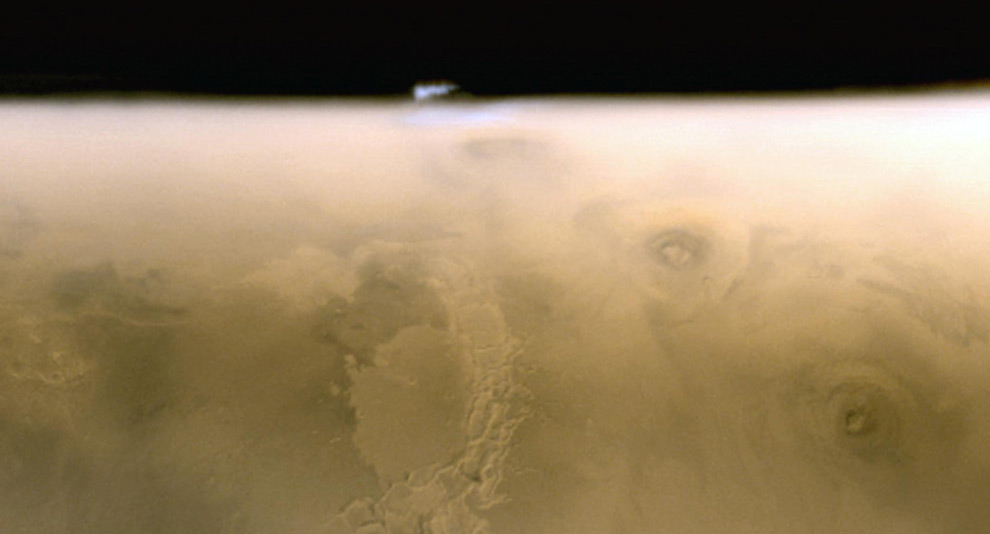 Mars' northern orange sky and horizon, seen by NASA's Phoenix Mars Lander. The lander's solar panel and Robotic Arm with a sample in the scoop are also visible. The image was taken by the lander's Surface Stereo Imager looking west during Phoenix's Sol 16 (June 10, 2008), or the 16th Martian day after landing. The image was taken just before the sample was delivered to the Optical Microscope. (NASA/JPL-Caltech/University of Arizona/Texas A&M University) The brownish gray sky at sunset as it would be seen by an observer on Mars - true color mosaic taken by Mars Pathfinder on sol 24 (June 22, 1996) The sky near the sun is a pale blue color. (NASA/JPL) High ice cloud over Mars' limb. This composite of red and blue Mars Global Surveyor (MGS) Mars Orbiter Camera (MOC) images acquired on 6 July 2005 shows an isolated water ice cloud extending more than 30 kilometers (more than 18 miles) above the Martian surface. Clouds such as this are common in late spring over the terrain located southwest of the Arsia Mons volcano. (NASA/JPL/Malin Space Science Systems).
Mars' northern orange sky and horizon, seen by NASA's Phoenix Mars Lander. The lander's solar panel and Robotic Arm with a sample in the scoop are also visible. The image was taken by the lander's Surface Stereo Imager looking west during Phoenix's Sol 16 (June 10, 2008), or the 16th Martian day after landing. The image was taken just before the sample was delivered to the Optical Microscope. (NASA/JPL-Caltech/University of Arizona/Texas A&M University) The brownish gray sky at sunset as it would be seen by an observer on Mars - true color mosaic taken by Mars Pathfinder on sol 24 (June 22, 1996) The sky near the sun is a pale blue color. (NASA/JPL) High ice cloud over Mars' limb. This composite of red and blue Mars Global Surveyor (MGS) Mars Orbiter Camera (MOC) images acquired on 6 July 2005 shows an isolated water ice cloud extending more than 30 kilometers (more than 18 miles) above the Martian surface. Clouds such as this are common in late spring over the terrain located southwest of the Arsia Mons volcano. (NASA/JPL/Malin Space Science Systems).
 Clouds over crater - the dust storm season in the southern hemisphere of Mars was well underway. This image of an unnamed crater southeast of Hellas Basin shows the encroachment of a storm in the region. Image acquired in 2001 by Mars Odyssey orbiter (17 meter/pixel resolution). (NASA/JPL/ASU).
Clouds over crater - the dust storm season in the southern hemisphere of Mars was well underway. This image of an unnamed crater southeast of Hellas Basin shows the encroachment of a storm in the region. Image acquired in 2001 by Mars Odyssey orbiter (17 meter/pixel resolution). (NASA/JPL/ASU).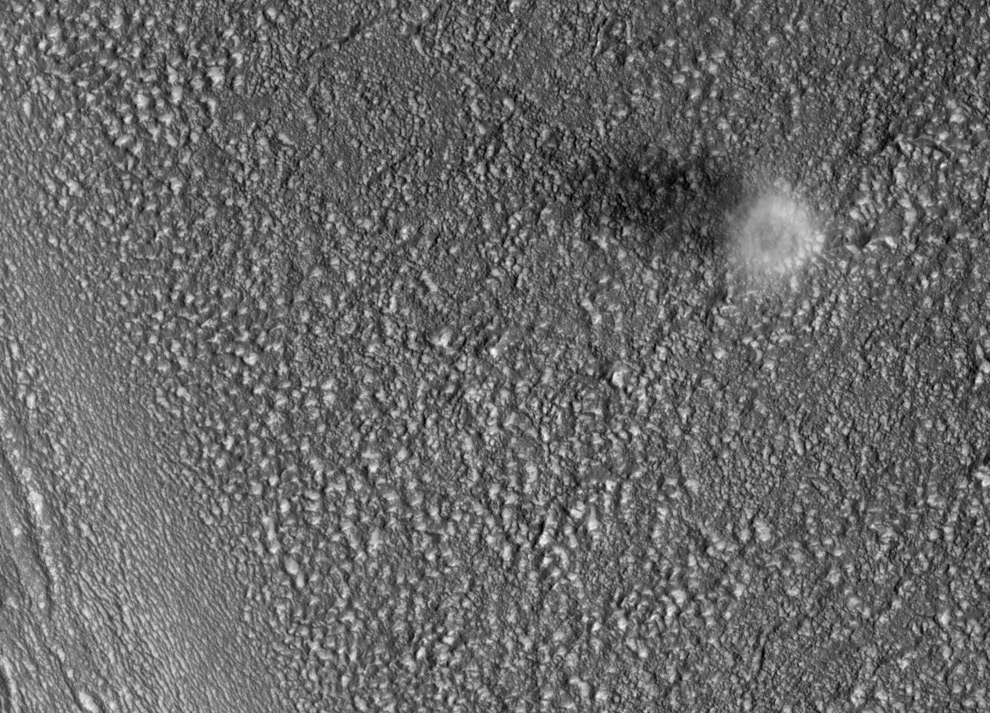 Dust devil from above. This image taken by the Hi-RISE Camera aboard NASA's Mars Reconnaissance Orbiter catches a dust devil blowing across the Martian surface. Dust devils generally form in the afternoon because the sunlight needs sufficient time to warm the surface. When this image was taken, the local time was about 3:08 p.m. The bright material is the dust within the vortex, and a dark shadow cast by the dust devil is visible to the left. The diameter of this dust devil is about 200 meters, but at the surface it is probably much smaller. Based on the length of the shadow in this image, the dust devil is on the order of 500 meters tall. (NASA/JPL/University of Arizona).
Dust devil from above. This image taken by the Hi-RISE Camera aboard NASA's Mars Reconnaissance Orbiter catches a dust devil blowing across the Martian surface. Dust devils generally form in the afternoon because the sunlight needs sufficient time to warm the surface. When this image was taken, the local time was about 3:08 p.m. The bright material is the dust within the vortex, and a dark shadow cast by the dust devil is visible to the left. The diameter of this dust devil is about 200 meters, but at the surface it is probably much smaller. Based on the length of the shadow in this image, the dust devil is on the order of 500 meters tall. (NASA/JPL/University of Arizona). Several dust devils cross a plain in this animation of a series of images acquired by NASA's Mars Rover Spirit in May, 2005. (NASA/JPL-Caltech/Cornell/USGS)
Several dust devils cross a plain in this animation of a series of images acquired by NASA's Mars Rover Spirit in May, 2005. (NASA/JPL-Caltech/Cornell/USGS) 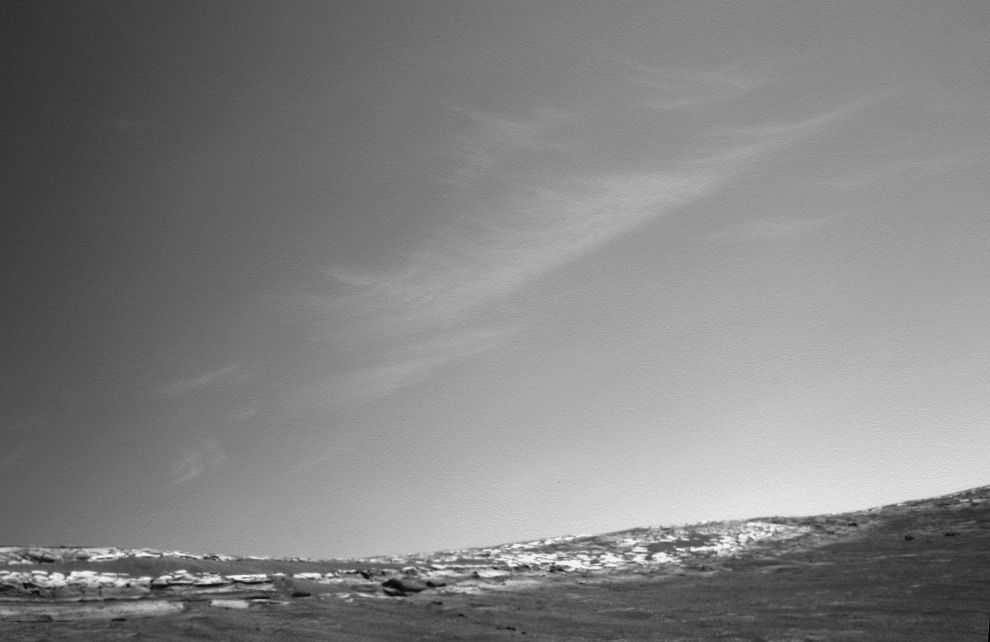 Clouds above the rim of "Endurance Crater" in this image from NASA's Mars Exploration Rover Opportunity. These clouds occur in a region of strong vertical shear. The cloud particles (ice in this martian case) fall out, and get dragged along away from the location where they originally condensed, forming characteristic streamers. Opportunity took this picture with its navigation camera during the rover's 269th martian day (Oct. 26, 2004). (NASA/JPL).
Clouds above the rim of "Endurance Crater" in this image from NASA's Mars Exploration Rover Opportunity. These clouds occur in a region of strong vertical shear. The cloud particles (ice in this martian case) fall out, and get dragged along away from the location where they originally condensed, forming characteristic streamers. Opportunity took this picture with its navigation camera during the rover's 269th martian day (Oct. 26, 2004). (NASA/JPL). Early Spring Dust Storms at the North Pole of Mars. Early spring typically brings dust storms to northern polar Mars. As the north polar cap begins to thaw, the temperature difference between the cold frost region and recently thawed surface results in swirling winds. The choppy dust clouds of several dust storms are visible in this mosaic of images taken by the Mars Global Surveyor spacecraft in 2002. The white polar cap is frozen carbon dioxide. (NASA/JPL/Malin Space Science Systems).
Early Spring Dust Storms at the North Pole of Mars. Early spring typically brings dust storms to northern polar Mars. As the north polar cap begins to thaw, the temperature difference between the cold frost region and recently thawed surface results in swirling winds. The choppy dust clouds of several dust storms are visible in this mosaic of images taken by the Mars Global Surveyor spacecraft in 2002. The white polar cap is frozen carbon dioxide. (NASA/JPL/Malin Space Science Systems).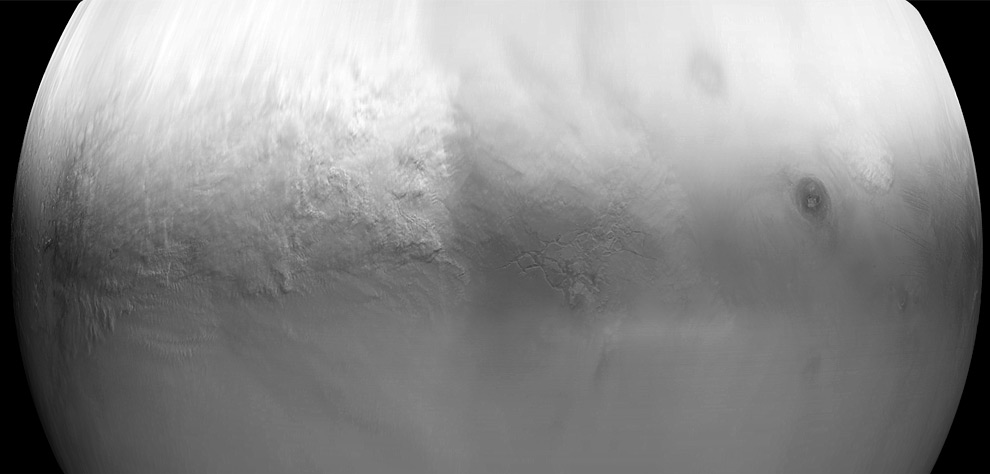 Large dust storms cover much of Mars' surface in this July, 2001 image, acquired by NASA's Mars Global Surveyor Mars Orbiter Camera. By early July, the martian atmosphere was so hazy that opportunities for high resolution imaging of the planet were very limited. (NASA/JPL/Malin Space Science Systems).
Large dust storms cover much of Mars' surface in this July, 2001 image, acquired by NASA's Mars Global Surveyor Mars Orbiter Camera. By early July, the martian atmosphere was so hazy that opportunities for high resolution imaging of the planet were very limited. (NASA/JPL/Malin Space Science Systems). The air is certainly thick enough to fill a parachute. On May 25th, 2008, the HiRISE camera onboard the Mars Reconnaissance Orbiter acquired this dramatic oblique image of the arrival of its sister probe from NASA, the Phoenix Lander, descending on its parachute. Phoenix and its parachute can be barely seen in the larger image with 10 km wide crater informally called "Heimdall" in the background. Although it appears that Phoenix is descending into the crater, it is actually about 20 kilometers in front of the crater. Given the position and pointing angle of MRO, Phoenix is at about 13 km above the surface, just a few seconds after the parachute opened. (NASA/JPL/University of Arizona).
The air is certainly thick enough to fill a parachute. On May 25th, 2008, the HiRISE camera onboard the Mars Reconnaissance Orbiter acquired this dramatic oblique image of the arrival of its sister probe from NASA, the Phoenix Lander, descending on its parachute. Phoenix and its parachute can be barely seen in the larger image with 10 km wide crater informally called "Heimdall" in the background. Although it appears that Phoenix is descending into the crater, it is actually about 20 kilometers in front of the crater. Given the position and pointing angle of MRO, Phoenix is at about 13 km above the surface, just a few seconds after the parachute opened. (NASA/JPL/University of Arizona).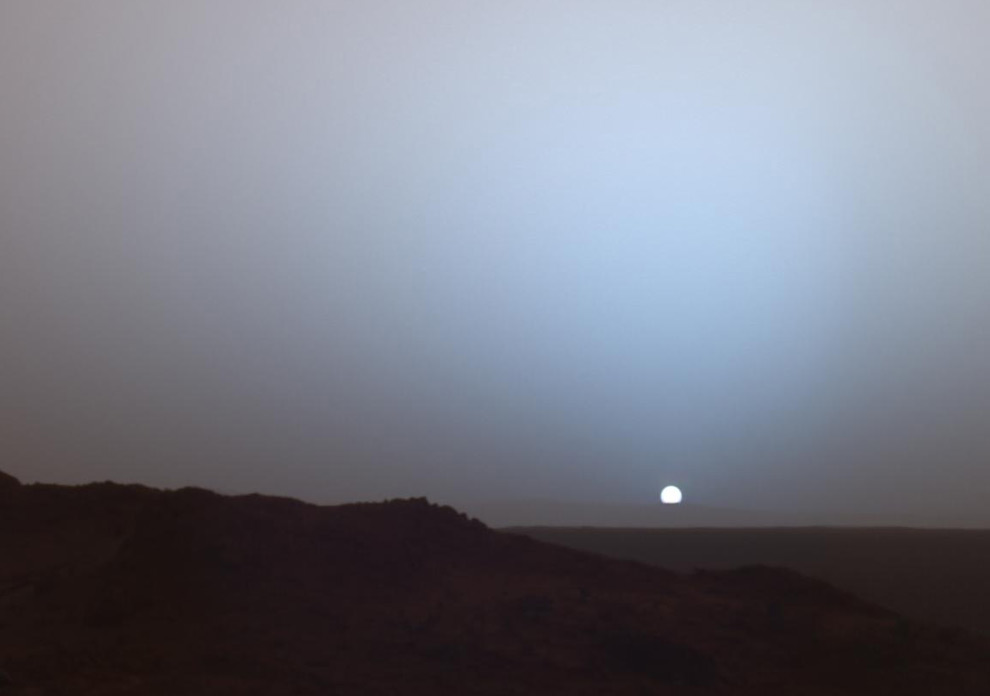 On May 19th, 2005, NASA's Mars Exploration Rover Spirit captured this stunning view as the Sun sank below the rim of Gusev crater on Mars. This Panoramic Camera mosaic was taken around 6:07 in the evening of the rover's 489th martian day, or sol. Spirit was commanded to stay awake briefly after sending that sol's data to the Mars Odyssey orbiter just before sunset. The image is a false color composite, showing the sky similar to what a human would see, but with the colors slightly exaggerated. (NASA/JPL/Texas A&M/Cornell).
On May 19th, 2005, NASA's Mars Exploration Rover Spirit captured this stunning view as the Sun sank below the rim of Gusev crater on Mars. This Panoramic Camera mosaic was taken around 6:07 in the evening of the rover's 489th martian day, or sol. Spirit was commanded to stay awake briefly after sending that sol's data to the Mars Odyssey orbiter just before sunset. The image is a false color composite, showing the sky similar to what a human would see, but with the colors slightly exaggerated. (NASA/JPL/Texas A&M/Cornell). Higher in the Martian skies, we see one of its two moons. The HiRISE camera onboard the Mars Reconnaissance Orbiter acquired this dramatic view of the Martian moon, Phobos, on 23 March 2008, from a distance of 6,800 kilometers. The illuminated part of Phobos is about 21 km across. The most prominent feature is the large impact crater Stickney, in the upper left. With a diameter of 9 km, it is the largest feature on Phobos. (NASA/JPL/University of Arizona).
Higher in the Martian skies, we see one of its two moons. The HiRISE camera onboard the Mars Reconnaissance Orbiter acquired this dramatic view of the Martian moon, Phobos, on 23 March 2008, from a distance of 6,800 kilometers. The illuminated part of Phobos is about 21 km across. The most prominent feature is the large impact crater Stickney, in the upper left. With a diameter of 9 km, it is the largest feature on Phobos. (NASA/JPL/University of Arizona).
More links and information at:
Live Martian Weather Report Canadian Space Agency On Mars No One Can Hear You Scream - studying the physical properties of sound on Mars.
MER Spirit dust devils - listing of many animations
Rosetta - ESA probe circling the inner Solar System, on its way to a rendezvous with Comet 67P/Churyumov-Gerasimenko in May 2014.
Mars Reconnaissance Orbiter - NASA probe
Mars Odyssey Orbiter - NASA probe, 2,432 Days in Orbit around Mars as of 6/20/2008
Phoenix Lander NASA probe on Mars's surface.
Mars Exploration Rovers - NASA's Spirit & Opportunity
ESA's Mars Express - ESA orbiter
Mars Science Laboratory NASA's new Mars rover, scheduled to launch in the Fall of 2009.
‘McMurdo' Panorama - panorama from NASA's Spirit rover
Info Source: by Alan Taylor © 2008 NY Times Co.
by Alan Taylor © 2008 NY Times Co.
Quick 1, 2, 3s about Mars' atmosphere
- It's hundreds of times thinner than Earth's atmosphere
- It's made up of 95% carbon dioxide, 3% nitrogen, 1.6% argon, and traces of oxygen, water, and methane.
- It can support dust storms, dust devils, clouds and gusty winds.
 Currently, there are six live probes exploring Mars (two rovers, a lander, and three orbiters). Below are a few best images of Martian showing the atmospheric phenomena. Check the Live Martian Weather Report, with data from a station on board the Phoenix Lander.High, wispy clouds cover a large portion of Mars, seen in this, the first true-colour image of Mars generated with the OSIRIS orange (red), green and blue color filters. The image was acquired by an instrument on the ESA's Rosetta probe on Feb. 24, 2007 from a distance of about 240,000 km. Image resolution is about 5 km/pixel.
Currently, there are six live probes exploring Mars (two rovers, a lander, and three orbiters). Below are a few best images of Martian showing the atmospheric phenomena. Check the Live Martian Weather Report, with data from a station on board the Phoenix Lander.High, wispy clouds cover a large portion of Mars, seen in this, the first true-colour image of Mars generated with the OSIRIS orange (red), green and blue color filters. The image was acquired by an instrument on the ESA's Rosetta probe on Feb. 24, 2007 from a distance of about 240,000 km. Image resolution is about 5 km/pixel.  Mars' northern orange sky and horizon, seen by NASA's Phoenix Mars Lander. The lander's solar panel and Robotic Arm with a sample in the scoop are also visible. The image was taken by the lander's Surface Stereo Imager looking west during Phoenix's Sol 16 (June 10, 2008), or the 16th Martian day after landing. The image was taken just before the sample was delivered to the Optical Microscope. (NASA/JPL-Caltech/University of Arizona/Texas A&M University) The brownish gray sky at sunset as it would be seen by an observer on Mars - true color mosaic taken by Mars Pathfinder on sol 24 (June 22, 1996) The sky near the sun is a pale blue color. (NASA/JPL) High ice cloud over Mars' limb. This composite of red and blue Mars Global Surveyor (MGS) Mars Orbiter Camera (MOC) images acquired on 6 July 2005 shows an isolated water ice cloud extending more than 30 kilometers (more than 18 miles) above the Martian surface. Clouds such as this are common in late spring over the terrain located southwest of the Arsia Mons volcano. (NASA/JPL/Malin Space Science Systems).
Mars' northern orange sky and horizon, seen by NASA's Phoenix Mars Lander. The lander's solar panel and Robotic Arm with a sample in the scoop are also visible. The image was taken by the lander's Surface Stereo Imager looking west during Phoenix's Sol 16 (June 10, 2008), or the 16th Martian day after landing. The image was taken just before the sample was delivered to the Optical Microscope. (NASA/JPL-Caltech/University of Arizona/Texas A&M University) The brownish gray sky at sunset as it would be seen by an observer on Mars - true color mosaic taken by Mars Pathfinder on sol 24 (June 22, 1996) The sky near the sun is a pale blue color. (NASA/JPL) High ice cloud over Mars' limb. This composite of red and blue Mars Global Surveyor (MGS) Mars Orbiter Camera (MOC) images acquired on 6 July 2005 shows an isolated water ice cloud extending more than 30 kilometers (more than 18 miles) above the Martian surface. Clouds such as this are common in late spring over the terrain located southwest of the Arsia Mons volcano. (NASA/JPL/Malin Space Science Systems). Clouds over crater - the dust storm season in the southern hemisphere of Mars was well underway. This image of an unnamed crater southeast of Hellas Basin shows the encroachment of a storm in the region. Image acquired in 2001 by Mars Odyssey orbiter (17 meter/pixel resolution). (NASA/JPL/ASU).
Clouds over crater - the dust storm season in the southern hemisphere of Mars was well underway. This image of an unnamed crater southeast of Hellas Basin shows the encroachment of a storm in the region. Image acquired in 2001 by Mars Odyssey orbiter (17 meter/pixel resolution). (NASA/JPL/ASU). Dust devil from above. This image taken by the Hi-RISE Camera aboard NASA's Mars Reconnaissance Orbiter catches a dust devil blowing across the Martian surface. Dust devils generally form in the afternoon because the sunlight needs sufficient time to warm the surface. When this image was taken, the local time was about 3:08 p.m. The bright material is the dust within the vortex, and a dark shadow cast by the dust devil is visible to the left. The diameter of this dust devil is about 200 meters, but at the surface it is probably much smaller. Based on the length of the shadow in this image, the dust devil is on the order of 500 meters tall. (NASA/JPL/University of Arizona).
Dust devil from above. This image taken by the Hi-RISE Camera aboard NASA's Mars Reconnaissance Orbiter catches a dust devil blowing across the Martian surface. Dust devils generally form in the afternoon because the sunlight needs sufficient time to warm the surface. When this image was taken, the local time was about 3:08 p.m. The bright material is the dust within the vortex, and a dark shadow cast by the dust devil is visible to the left. The diameter of this dust devil is about 200 meters, but at the surface it is probably much smaller. Based on the length of the shadow in this image, the dust devil is on the order of 500 meters tall. (NASA/JPL/University of Arizona). Several dust devils cross a plain in this animation of a series of images acquired by NASA's Mars Rover Spirit in May, 2005. (NASA/JPL-Caltech/Cornell/USGS)
Several dust devils cross a plain in this animation of a series of images acquired by NASA's Mars Rover Spirit in May, 2005. (NASA/JPL-Caltech/Cornell/USGS)  Clouds above the rim of "Endurance Crater" in this image from NASA's Mars Exploration Rover Opportunity. These clouds occur in a region of strong vertical shear. The cloud particles (ice in this martian case) fall out, and get dragged along away from the location where they originally condensed, forming characteristic streamers. Opportunity took this picture with its navigation camera during the rover's 269th martian day (Oct. 26, 2004). (NASA/JPL).
Clouds above the rim of "Endurance Crater" in this image from NASA's Mars Exploration Rover Opportunity. These clouds occur in a region of strong vertical shear. The cloud particles (ice in this martian case) fall out, and get dragged along away from the location where they originally condensed, forming characteristic streamers. Opportunity took this picture with its navigation camera during the rover's 269th martian day (Oct. 26, 2004). (NASA/JPL). Early Spring Dust Storms at the North Pole of Mars. Early spring typically brings dust storms to northern polar Mars. As the north polar cap begins to thaw, the temperature difference between the cold frost region and recently thawed surface results in swirling winds. The choppy dust clouds of several dust storms are visible in this mosaic of images taken by the Mars Global Surveyor spacecraft in 2002. The white polar cap is frozen carbon dioxide. (NASA/JPL/Malin Space Science Systems).
Early Spring Dust Storms at the North Pole of Mars. Early spring typically brings dust storms to northern polar Mars. As the north polar cap begins to thaw, the temperature difference between the cold frost region and recently thawed surface results in swirling winds. The choppy dust clouds of several dust storms are visible in this mosaic of images taken by the Mars Global Surveyor spacecraft in 2002. The white polar cap is frozen carbon dioxide. (NASA/JPL/Malin Space Science Systems). Large dust storms cover much of Mars' surface in this July, 2001 image, acquired by NASA's Mars Global Surveyor Mars Orbiter Camera. By early July, the martian atmosphere was so hazy that opportunities for high resolution imaging of the planet were very limited. (NASA/JPL/Malin Space Science Systems).
Large dust storms cover much of Mars' surface in this July, 2001 image, acquired by NASA's Mars Global Surveyor Mars Orbiter Camera. By early July, the martian atmosphere was so hazy that opportunities for high resolution imaging of the planet were very limited. (NASA/JPL/Malin Space Science Systems). The air is certainly thick enough to fill a parachute. On May 25th, 2008, the HiRISE camera onboard the Mars Reconnaissance Orbiter acquired this dramatic oblique image of the arrival of its sister probe from NASA, the Phoenix Lander, descending on its parachute. Phoenix and its parachute can be barely seen in the larger image with 10 km wide crater informally called "Heimdall" in the background. Although it appears that Phoenix is descending into the crater, it is actually about 20 kilometers in front of the crater. Given the position and pointing angle of MRO, Phoenix is at about 13 km above the surface, just a few seconds after the parachute opened. (NASA/JPL/University of Arizona).
The air is certainly thick enough to fill a parachute. On May 25th, 2008, the HiRISE camera onboard the Mars Reconnaissance Orbiter acquired this dramatic oblique image of the arrival of its sister probe from NASA, the Phoenix Lander, descending on its parachute. Phoenix and its parachute can be barely seen in the larger image with 10 km wide crater informally called "Heimdall" in the background. Although it appears that Phoenix is descending into the crater, it is actually about 20 kilometers in front of the crater. Given the position and pointing angle of MRO, Phoenix is at about 13 km above the surface, just a few seconds after the parachute opened. (NASA/JPL/University of Arizona). On May 19th, 2005, NASA's Mars Exploration Rover Spirit captured this stunning view as the Sun sank below the rim of Gusev crater on Mars. This Panoramic Camera mosaic was taken around 6:07 in the evening of the rover's 489th martian day, or sol. Spirit was commanded to stay awake briefly after sending that sol's data to the Mars Odyssey orbiter just before sunset. The image is a false color composite, showing the sky similar to what a human would see, but with the colors slightly exaggerated. (NASA/JPL/Texas A&M/Cornell).
On May 19th, 2005, NASA's Mars Exploration Rover Spirit captured this stunning view as the Sun sank below the rim of Gusev crater on Mars. This Panoramic Camera mosaic was taken around 6:07 in the evening of the rover's 489th martian day, or sol. Spirit was commanded to stay awake briefly after sending that sol's data to the Mars Odyssey orbiter just before sunset. The image is a false color composite, showing the sky similar to what a human would see, but with the colors slightly exaggerated. (NASA/JPL/Texas A&M/Cornell). Higher in the Martian skies, we see one of its two moons. The HiRISE camera onboard the Mars Reconnaissance Orbiter acquired this dramatic view of the Martian moon, Phobos, on 23 March 2008, from a distance of 6,800 kilometers. The illuminated part of Phobos is about 21 km across. The most prominent feature is the large impact crater Stickney, in the upper left. With a diameter of 9 km, it is the largest feature on Phobos. (NASA/JPL/University of Arizona).
Higher in the Martian skies, we see one of its two moons. The HiRISE camera onboard the Mars Reconnaissance Orbiter acquired this dramatic view of the Martian moon, Phobos, on 23 March 2008, from a distance of 6,800 kilometers. The illuminated part of Phobos is about 21 km across. The most prominent feature is the large impact crater Stickney, in the upper left. With a diameter of 9 km, it is the largest feature on Phobos. (NASA/JPL/University of Arizona).More links and information at:
Live Martian Weather Report Canadian Space Agency On Mars No One Can Hear You Scream - studying the physical properties of sound on Mars.
MER Spirit dust devils - listing of many animations
Rosetta - ESA probe circling the inner Solar System, on its way to a rendezvous with Comet 67P/Churyumov-Gerasimenko in May 2014.
Mars Reconnaissance Orbiter - NASA probe
Mars Odyssey Orbiter - NASA probe, 2,432 Days in Orbit around Mars as of 6/20/2008
Phoenix Lander NASA probe on Mars's surface.
Mars Exploration Rovers - NASA's Spirit & Opportunity
ESA's Mars Express - ESA orbiter
Mars Science Laboratory NASA's new Mars rover, scheduled to launch in the Fall of 2009.
‘McMurdo' Panorama - panorama from NASA's Spirit rover
Info Source:



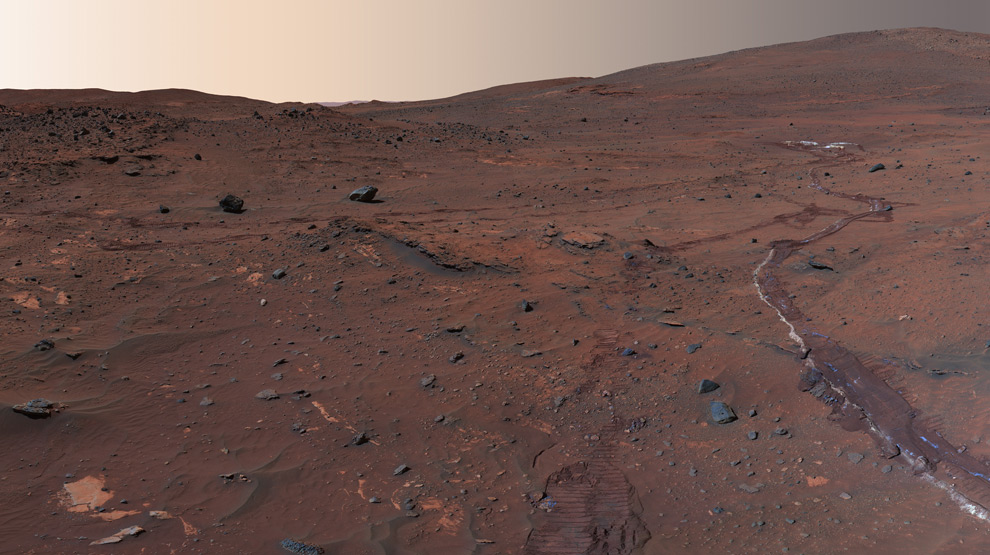

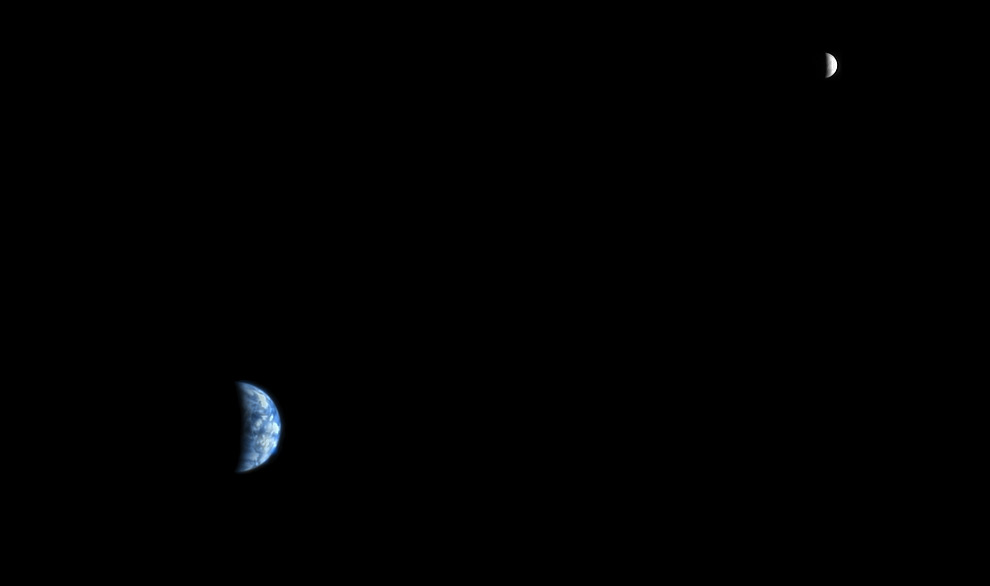



0 feedback :